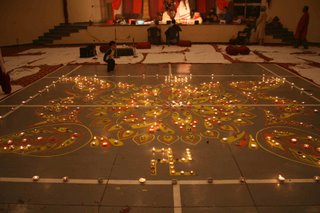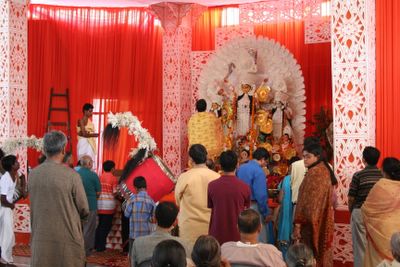



 Diwali or Deepavali (Hindi word from "Deep" meaning "Diya" or earthen oil lamp where you put oil and wick made of cotton to light up) is a Festival celebrated by India - this year was celebrated on 21/10/2006 in the North. South India celebrated it on 20/10/2006. The whole Indian Culture is very confusing to outsiders, even I get confused at times. After all I being a Bengali belonging to Calcutta do not celebrate Diwali like the North Indians do, but we worship Goddess Kali on this day but we too light up our houses with lights and lamps and candles. And we too burst firecrackers like those who celebrate Diwali. But then those who celebrate Diwali in the North worship God Ganesh (the one who looks like an Elephant head on a man's body- because his head was cut off and then replaced by the first living being that was seen by the seeker of a replacement and as chance would have it, it was an elephant- so be it, the elephant's head was used) and also Lakhsmi and both are looked as God of wealth, though we Bengalis worship Goddess Lakhsmi as the one brings in wealth on the 3 rd day after DURGA Puja and on all thursdays. So to get money too we pray to different Gods.. hmm. very confusing indeed. And why not ? The Hindus have innumerable Gods and Goddesses-... while the Muslims and Christians worship only one God.. so you see how diverse India is? On top of having so many religions living in India side by side the majority religion itself has so many diversifications!! Like as I said North Indians celebrate Diwali time God Ganesh and God Lakshmi & Bengalis worship Goddess Lakshmi on a different day. But while Diwali is also time to pray by the businessmen and so the shops and buisness houses are lighted up for more wealth and Pujas are performed..Bengali business people do it on Bengali New year which is arounf 15th April give or take a couple of days. I think I will not confuse you people anymore.
Diwali or Deepavali (Hindi word from "Deep" meaning "Diya" or earthen oil lamp where you put oil and wick made of cotton to light up) is a Festival celebrated by India - this year was celebrated on 21/10/2006 in the North. South India celebrated it on 20/10/2006. The whole Indian Culture is very confusing to outsiders, even I get confused at times. After all I being a Bengali belonging to Calcutta do not celebrate Diwali like the North Indians do, but we worship Goddess Kali on this day but we too light up our houses with lights and lamps and candles. And we too burst firecrackers like those who celebrate Diwali. But then those who celebrate Diwali in the North worship God Ganesh (the one who looks like an Elephant head on a man's body- because his head was cut off and then replaced by the first living being that was seen by the seeker of a replacement and as chance would have it, it was an elephant- so be it, the elephant's head was used) and also Lakhsmi and both are looked as God of wealth, though we Bengalis worship Goddess Lakhsmi as the one brings in wealth on the 3 rd day after DURGA Puja and on all thursdays. So to get money too we pray to different Gods.. hmm. very confusing indeed. And why not ? The Hindus have innumerable Gods and Goddesses-... while the Muslims and Christians worship only one God.. so you see how diverse India is? On top of having so many religions living in India side by side the majority religion itself has so many diversifications!! Like as I said North Indians celebrate Diwali time God Ganesh and God Lakshmi & Bengalis worship Goddess Lakshmi on a different day. But while Diwali is also time to pray by the businessmen and so the shops and buisness houses are lighted up for more wealth and Pujas are performed..Bengali business people do it on Bengali New year which is arounf 15th April give or take a couple of days. I think I will not confuse you people anymore.Let me share something about Diwali:-
Deepo ka tyohar Deepavali.... (Deepo means lamps. Ka means of Tyohar means festival. SO it MEANS Festival of lamps Deepavali or diwali)
Celebrated in the month of Kartik (October / November) as per the Hinducalendar every year. Deepavali is celebrated for five consecutive days aseach day has its own significance.
The First day is called DHANTERAS The word "Dhan" means wealth. This day isof great importance to the business community as they worship "Lakshmi" onthis day.
The Second day is called NARKA-CHATURDASHI, which falls on the fourteenthday of the month of Kartik.
One legend for this is that demon King Narakasur after defeating Lord Indrasnatched away the magnificent earrings of Aditi, the Mother Goddess andimprisoned sixteen thousand daughters of the gods and saints in his harem.On the day preceding Narakachaturdashi, Lord Krishna killed the demon andfreed the imprisoned damsels and also recovered the precious earrings ofAditi. He then celebrated his victory by smearing his forehead with thedemon king's blood. When he returned to his palace the womenfolk massagedhim with scented oil and gave him a good bath. The custom of taking a bathwith scented oil and "Uptan" before sunrise is stillprevalent especially inMaharashtra.
The Third day of the festival of Diwali is the most important day ofLakshmi-Puja, which is entirely devoted to the Goddess Lakshmi. Themythical belief is that on this day Lakshmi emergedfrom the ocean.
It comes 21 days after Dussehra and also celebrates the return of Lord Ramato Ayodhya after his 14-year exile. Homes are decorated, sweets aredistributed to everyone and thousands of lamps lit in houses all over thecountry making it a night of enchantment. Doorways are hung with torans (adecorative garland for the door) of mango leaves and marigolds. Rangolis(designs on floor) are drawn with different coloured powders to welcomeguests. Worship of Goddess Lakshmi, festivities are an essential part ofthe occasion. It is believed that on this day Lakshmi walks the earth inevery bye-lane and showers her blessings on each householdfor prosperity.
This day is also known by the name of "Chopada-Puja". The day ofLakshmi-Puja falls on the dark night of Amavasya (new moon). It is believedthat on this auspicious day Lord Krishna discarded his body.
The Fourth day is Padwa or Varshapratipada, which marks the coronation ofKing Vikramaditya, and Vikaram-Samvat was started from this day. This dayis also known as ‘Dhoka’ and comes only once every four years.
The Fifth and final day of Diwali Festival is known by the name Bhaiya-Doojor Bhav-Bij or Bhai-Tika This day is observed as a symbol of love betweensisters and brothers.
The legendary belief is that on this day Yamraj -the god of death visitedhis sister Yami and she put the auspicious tilak on his forehead. Theyspent the day together, talking, eating, sharing stories of their lives andexchanged special gifts as a token of their love for each other. Yamrajthen announced that anyone who receives tilak from his sister on this daywould never be over thrown. Since then it became symbolic for the brotherto go to his sister's house to celebrate this day.
And here are some photos of Goddess Kali being worshipped and some oil lamps in the foreground. (Depends on the organiser of such community "Pujas" how the decorations will be done). Calcutta sites would show more lights and added attractions. This one was at Delhi celebrated by Bengalis there.

Well because I did not go out of my place I could not take better pictures of more lights but this gives a good idea of what that more can be. And tomorrow I will post some modest photos of some fireworks.
And what about fireworks?











